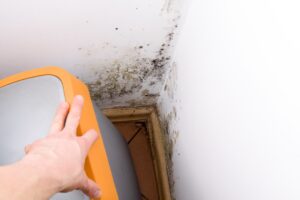Purchasing a new home can be extremely stressful. You have to examine all aspects of the home — and that’s after you’ve already found the one you like. Unfortunately, sometimes you will still end up with a home that needs more repairs than you originally planned for.
Mold is one of those things that can creep into a home without getting noticed before it’s too late. Moreover, if left untreated, it can eat its way into the walls and cause structural damage.
If you want to know how to avoid throwing away your life savings on a moldy home — you’re in the right place. In this article, you’ll learn what to look for, and how to deal with any existing mold issues. But before that, let’s see what having mold can do to a home.
The Dangers of Mold in a Home
Mold thrives in humid environments and is a direct consequence of high humidity. It comes in all shapes and colors, and sometimes it’s completely odorless. It loves dark, humid places and you can find it both inside and outside the walls of your home. The most likely places for mold to grow are:
- Around leaky pipes, windows, and roofs
- Homes with tightly sealed walls
- Basements
- Poorly ventilated homes
In addition to being unsightly and smelly, mold can cause serious, even fatal health issues. While most people will start getting a scratchy throat or runny nose, some can experience violent allergic reactions. Also, although most types of mold aren’t detrimental to the majority of the population, some can be toxic and cause a variety of health issues. (See Common Types of Mold)
Inspecting a Home for Mold
If you’re examining the home by yourself, there are a few signs you should always be on the lookout for. So, let’s talk about the steps you need to take to ensure your dream home doesn’t turn into a big problem because of mold.
Examine the Walls and the Elements
You should inspect the basement, bathroom, laundry room, kitchen, or cabinets with the plumbing inside for the musty smell of mold. However, you shouldn’t rely solely on your sense of smell to tell you if a home has issues with mold. Although its particular smell can alert you to a possible issue — some types of mold are completely odorless.
You should also examine all of the walls and cabinets for obvious signs of mold, or the fact that someone tried to mask them. Freshly painted areas can sometimes indicate that the owner is trying to hide moisture or other types of damage. Closely inspect the walls for watermarks, especially at the bottom.
Ask the Right Questions
If you do notice evidence of someone covering up the mold, ask the current owner of the home to give you an honest answer. You could also play detective, and ask if the home has had any pipe bursts or leaky windows in the past. Now is not the time to be shy; make sure you know what you’re getting yourself into before making a huge investment.
Additionally, you should also inquire if the home was built with the Exterior Insulation and Finish System (EIFS), also known as synthetic stucco. The method is meant to improve the insulation but can cause mold to grow if it’s not installed properly.
Lastly, ask your inspector to tell you if he or she notices obvious signs of water damage. Although it’s not in their job description to inspect homes for mold specifically, they’ll know what to look for.
Know Your Rights
In some states, sellers are obligated to tell you if there’s a mold issue in the house. Additionally, real estate agents and appraisers have to tell you if they’re aware of any existing structural problems. However, this doesn’t mean that they must inspect every inch of the home for mold, just that they need to tell you about the issues they should realistically know about already.
Additionally, know that this isn’t required by the law in all parts of the USA, and if that’s the case — you should still ask.
Final Thoughts
It’s not the end of the world if you discover that the home you’re dying to purchase has some mold issues. It’s up to you to decide if you want to walk away or deal with the cost of removing it. However, keep in mind that you’ll also have to deal with treating the underlying cause. So you might also need to invest in new piping or devices for reducing high levels of humidity.
You can also take extra precautions and hire a mold inspection company like Mold Solutions to come and examine the home– It’s well worth it. Nevertheless, you can always rely on the methods listed in this article to see if there’s signs of mold hiding in your dream home.








